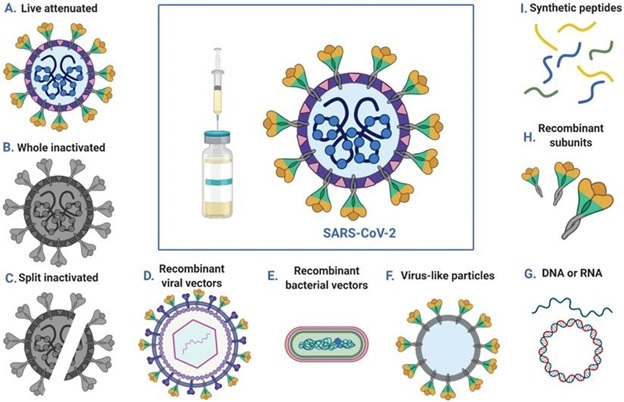Types of vaccine: Vaccines can be synthesized in many ways based on which they are classified:
1. Live attenuated vaccines
Pathogens like virus or bacteria are weakened by genetic manipulations to limit its growth and thus do not cause disease to the host. In some modified versions of live vaccine an organism that is related to the pathogen is used that naturally grows poorly in humans. The weakened pathogen generates a broad immune response in the host similar to that shown by an infected individual with a natural pathogen.
Examples:
- Oral Sabin polio vaccine
- MRV Vaccine (Measles, Mumps, Rubella, and Varicella)
- Nasal influenza vaccine
- Bacille Calmette-Guerin (BCG) vaccine
- Varicella vaccine
- Rotavirus vaccine
2. Inactivated or Dead vaccines
The disease-causing pathogen is killed or inactivated, usually through a thermal (application of high temperature) or chemical (formalin etc.) process. Such vaccines, when administered, elicit a robust immune response that mimics most of the responses seen during an infection.
Examples:
- Typhoid vaccine
- Influenza vaccine
- Salk polio vaccine
- Hepatitis A vaccine
3. Acellular or Subunit vaccines
Acellular means not containing the whole cells. Acellular vaccines do not contain the whole bacteria or viruses. Instead, they contain polysaccharides or proteins from the surface of the bacteria or virus. These polysaccharides or proteins are the parts that our immune system recognizes as ‘foreign’ and evoke immune response against them. There are many types of a cellular vaccines:
A. Toxoid Vaccine: Some pathogenic bacteria release toxins or poisonous proteins when they attack the body. Some vaccines are made by inactivating these toxins chemically and called ‘toxoids’, because they look like toxins but not poisonous. They trigger a strong immune response.
Examples:
- Diphtheria vaccine
- Tetanus vaccine
- Pertussis vaccine
B. Conjugate Vaccine: Earlier polysaccharide vaccines were made using sugar molecules present on the surface of the bacteria but it was found to be less effective in babies and young children. Researchers discovered that these vaccines can work better if the bacterial polysaccharide molecules are chemically linked or conjugated to a carrier protein. Addition of other proteins confers the immunological attributes of the carrier to the antigen and thus induces a stronger immune response effective enough for younger children also.
Examples:
- Haemophilus influenza type b (Hib) conjugate vaccine
- Pneumococcal conjugate vaccine
- Meningococcal C conjugate vaccine
C. Recombinant Vaccine: A small piece of the DNA is taken from the disease-causing bacterium or virus. The particular gene is incorporated into plasmid or a carrier vehicle which enables production of large quantities of well-defined proteins, which are then used as vaccines.
Examples:
- Hepatitis B vaccine
- Human papillomavirus (HPV) vaccine
D. DNA/RNA Vaccine: Genetic material, either DNA or RNA, from the pathogenic bacteria or virus is introduced into the human cells and then the cell machinery is employed to produce the protein encoded by the inserted gene(s) of the pathogen. Our body’s immune system detects such protein as a foreign agent and produces an immune response against the whole pathogen. At present, different types of nucleic-acid vaccines are in developmental, pre-clinical and clinical evaluation phases e.g HIV vaccine
